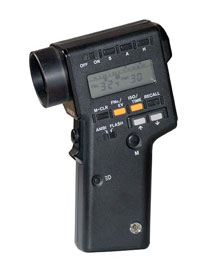Gamma 1 Metering
Gamma 1 metering provides complete information about the scene to be captured. Today's digital cameras and capture applications typically employ a histogram as the main reporting vehicle to provide information about the scene to be captured. This can be problematic unless the photographer intends to use the development (density remap) the histogram is based on. Generally the histogram on the back of the camera does not reflect the RAW translation that will be used to translate/develop the file after the capture. But the histogram is not a good alternative to a proper light meter. Most histograms do not display the distribution of tones in the scene, but the distribution of tones after "development" - it shows what the tonality will look like if the camera makes a .jpg or.tif. The picture seen on the back of the camera is based on the same "development"; the picture and the histogram should, in fact, have some similarity to be considered worthwhile. A problem arises however, when the photographer does not intend on using the camera's development of the scene. The photographer's intention may be to shoot RAW in which case the camera's .jpg histogram has serious limitations. Histograms are also potentially difficult to read if the scene to be captured is in an especially high or low key, because the data stacks are not (and shouldn't be) in the middle. Highly considered images typically involve the shooter deciding the density remap using RAW files, instead of using the camera's developed (and histogram based) .jpg or .tif image. In most cases an exposure is articulated in front of a computer, rather than at the scene. MegaVision products offer the luxury to have a computer involved at the scene where different RAW developments can be experimented with, and exposure adjusted to optimize development. 
The typical developed picture and its histogram are the reasons why a proper light meter is a superior tool in reporting important scene brightness. Instead of reporting a single density remap, a traditional reflective spot meter simply reports the light energy reflecting from the scene. The user decides what is important, points the spot meter appropriately, and reads the reflectance reports. With a traditional reflective spot meter there is no development or density remap to consider. The photographer can view how many f-stops each area of importance is, from any other area of importance. This is essential information in deciding the development to use. Unlike the digital camera's picture display, the spot meter has no 2.2 display gamma adjustment and no .jpg development intention. By using the spot meter's area of sensitivity selectively, the photographer can see reflectance reports that are important to the shooter. In comparison, the typical data stacks of a histogram do not support reporting the most important low, middle, or high value. Ansel Adams taught the use of a reflective spot meter to count the number of stops (or zones) between the most important high and low values. The number of stops dictated the development so the resulting image could fit the paper. A spot meter is a simple tool which is easy to understand, and is critical in the evaluation of the scene and the crafting of tonality for the target. When using gamma 1 metering, a picture display appears. Although gamma 1 images may look terrible, they do have diagnostic value, because the image reveals the light energy that lands on the sensor without any contrast enhancing. This means that a gamma 1 image demonstrates the tonality of the highs - unadulterated by a remap. After review of the image the photographer can make changes to the image. It is possible to zoom the display to 800% to see into the brighter highs, an advantage when evaluating the fine detail that can be difficult with the naked eye. A great digital meter would read just like a traditional reflective spot meter (gamma 1) but would also provide a density remap, with or without a display gamma. Each meter would switch on and off at the click of a button so the photographer could go back and forth effortlessly. Going beyond the remaps of the traditional digital camera, the meter would make and display multiple remaps and reflect the rendering characterizations of various papers. The perfect meter would inform the shooter of any scene attribute that really matters. The MegaVision Photoshoot meter does just that - it reports luminance, and displays it in zones, ink percentages, or RGB levels making it easy to choose the report that is preferred. It's all part of the Photoshoot 4 metering and the MegaVision Workflow. Because MegaVision's Workflow involves a computer, the photographer can select the preferred metering. The increase in information that this technology makes available to the photographer allows the photographer to craft images of excellence. When it comes to picture making, why settle for anything less? |

